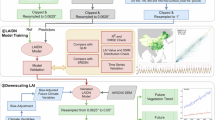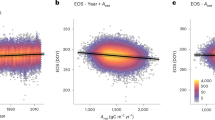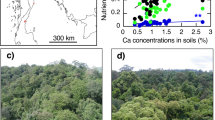Abstract
Increasing leaf area and extending vegetation growing seasons are two primary drivers of global greening, which has emerged as one of the most significant responses to climate change. However, it remains unclear how these two leaf acclimation strategies would vary across forests at a large spatial scale. Here, using multiple satellite-based datasets and field measurements, we analysed the temporal changes (Δ) in maximal leaf area index (LAImax) and length of the growing season (LOS) from 2002 to 2021 across deciduous broadleaf forests (DBFs) in the middle to high latitudes. Contrary to the widely held assumption of coordination, our results revealed a negative correlation between ΔLAImax and ΔLOS. Notably, the trade-offs between ΔLAImax and ΔLOS were strongly explained by stand age. Younger DBFs, with lower baseline LAImax, predominantly located in eastern Asia, displayed an increase in LAImax with small changes in LOS. This acquisitive strategy facilitated younger DBFs to grow more photosynthetically efficient leaves with low leaf mass per area, enhancing their light use efficiency. Conversely, older DBFs with a higher baseline LAImax, primarily located in North America and Europe, extended their LOS by increasing leaf mass per area. This conservative strategy facilitated older DBFs to produce thicker, but less photosynthetically efficient leaves, resulting in decreased light use efficiency. Our findings offer new insights into the contrasting changes in leaf area and growing season length and highlight their divergent impacts on ecosystem functioning.
This is a preview of subscription content, access via your institution
Access options
Access Nature and 54 other Nature Portfolio journals
Get Nature+, our best-value online-access subscription
$32.99 / 30 days
cancel any time
Subscribe to this journal
Receive 12 digital issues and online access to articles
$119.00 per year
only $9.92 per issue
Buy this article
- Purchase on SpringerLink
- Instant access to full article PDF
Prices may be subject to local taxes which are calculated during checkout




Similar content being viewed by others
Data availability
All the relevant data come from publicly available sources. The GLASS LAI (01B01.V60) product is available at http://www.glass.umd.edu/LAI/MODIS/0.05D/; the satellite leaf unfolding and dormancy dates product is available at https://lpdaac.usgs.gov/products/mcd12q2v061/; the MPI-BGC stand age data are available at https://doi.org/10.17871/ForestAgeBGI.2021; the MODIS Nadir BRDF-Adjusted Reflectance (NBAR) products (MCD43A4) are available via Google Earth Engine at https://developers.google.com/earth-engine/datasets/catalog/MODIS_061_MCD43A4; the LMC data are available via Zenodo at https://doi.org/10.5281/zenodo.6545571; the BESS v2.0 GPP data are available at https://www.environment.snu.ac.kr/bessv2; the GLASS PAR (04B01.V60) product is available at http://www.glass.umd.edu/PAR/; the GLASS fAPAR (09B01.V60) product is available at http://www.glass.umd.edu/FAPAR/MODIS/0.05D/; the Global Land cover data are available at https://lpdaac.usgs.gov/products/mcd12c1v061/; the MOD13Q1 V061 EVI data are available at https://lpdaac.usgs.gov/products/mod13q1v061/; the in situ leaf unfolding date products of Europe, Russia and the USA, respectively, are available at http://www.pep725.eu, https://doi.org/10.1038/s41597-020-0376-z and https://www.usanpn.org/data/observational; the TRY database is available at https://www.try-db.org/; the MODIS FireCCILT11 (version 1.1) data are available at https://catalogue.ceda.ac.uk/uuid/b1bd715112ca43ab948226d11d72b85e/; the GFW Global Forest Change v1.9 data are available at https://glad.earthengine.app/view/global-forest-change; the Palmer Drought Severity Index data are available at https://climate.northwestknowledge.net/TERRACLIMATE.
Code availability
The code used for this study is available via Zenodo at https://doi.org/10.5281/zenodo.15765680 (ref. 87).
References
Guo, K. et al. Leaf morphogenesis: the multifaceted roles of mechanics. Mol. Plant 15, 1098–1119 (2022).
Liu, J. et al. Evidence for widespread thermal acclimation of canopy photosynthesis. Nat. Plants 10, 1919–1927 (2024).
Piao, S. et al. Leaf onset in the northern hemisphere triggered by daytime temperature. Nat. Commun. 6, 6911 (2015).
Zhu, Z. et al. Greening of the Earth and its drivers. Nat. Clim. Change 6, 791–795 (2016).
Jian, D. et al. Limited driving of elevated CO2 on vegetation greening over global drylands. Environ. Res. Lett. 18, 104024 (2023).
Buitenwerf, R., Rose, L. & Higgins, S. I. Three decades of multi-dimensional change in global leaf phenology. Nat. Clim. Change 5, 364–368 (2015).
Chen, C. et al. China and India lead in greening of the world through land-use management. Nat. Sustain. 2, 122–129 (2019).
Wu, C. et al. Contrasting responses of autumn-leaf senescence to daytime and night-time warming. Nat. Clim. Change 8, 1092–1096 (2018).
Chen, C. et al. Biophysical impacts of Earth greening largely controlled by aerodynamic resistance. Sci. Adv. 6, eabb1981 (2020).
Xia, J. et al. Joint control of terrestrial gross primary productivity by plant phenology and physiology. Proc. Natl Acad. Sci. USA 112, 2788–2793 (2015).
Huang, K. et al. Enhanced peak growth of global vegetation and its key mechanisms. Nat. Ecol. Evol. 2, 1897–1905 (2018).
Zhu, W. et al. Extension of the growing season due to delayed autumn over mid and high latitudes in North America during 1982–2006. Glob. Ecol. Biogeogr. 21, 260–271 (2012).
Fu, Y. H. et al. Declining global warming effects on the phenology of spring leaf unfolding. Nature 526, 104–107 (2015).
Zani, D. et al. Increased growing-season productivity drives earlier autumn leaf senescence in temperate trees. Science 370, 1066–1071 (2020).
Menzel, A. & Fabian, P. Growing season extended in Europe. Nature 397, 659 (1999).
Gunderson, C. A. et al. Forest phenology and a warmer climate—growing season extension in relation to climatic provenance. Glob. Change Biol. 18, 2008–2025 (2012).
Liu, Q. et al. Extension of the growing season increases vegetation exposure to frost. Nat. Commun. 9, 426 (2018).
Wang, X. et al. No trends in spring and autumn phenology during the global warming hiatus. Nat. Commun. 10, 2389 (2019).
Piao, S. et al. Characteristics, drivers and feedbacks of global greening. Nat. Rev. Earth Environ. 1, 14–27 (2020).
Reich, P. B., Walters, M. B. & Ellsworth, D. S. Leaf life-span in relation to leaf, plant, and stand characteristics among diverse ecosystems. Ecol. Monogr. 62, 365–392 (1992).
Wright, I. J. et al. The worldwide leaf economics spectrum. Nature 428, 821–827 (2004).
Reich, P. B., Walters, M. B. & Ellsworth, D. S. From tropics to tundra: global convergence in plant functioning. Proc. Natl Acad. Sci. USA 94, 13730–13734 (1997).
Reich, P. B. & Flores-Moreno, H. Peeking beneath the hood of the leaf economics spectrum. N. Phytol. 214, 1395–1397 (2017).
Chazdon, R. L. Beyond deforestation: restoring forests and ecosystem services on degraded lands. Science 320, 1458–1460 (2008).
Yan, K. et al. Performance stability of the MODIS and VIIRS LAI algorithms inferred from analysis of long time series of products. Remote Sens. Environ. 260, 112438 (2021).
Gao, S. et al. Evaluating the saturation effect of vegetation indices in forests using 3D radiative transfer simulations and satellite observations. Remote Sens. Environ. 295, 113665 (2023).
Ma, H. & Liang, S. Development of the GLASS 250-m leaf area index product (version 6) from MODIS data using the bidirectional LSTM deep learning model. Remote Sens. Environ. 273, 112985 (2022).
Friedl, M., Gray, J., & Sulla-Menashe, D. MODIS/Terra+ Aqua Land Cover Dynamics Yearly L3 Global 500 m SIN Grid V061. NASA EOSDIS Land Processes DAAC https://doi.org/10.5067/MODIS/MCD12Q2.061 (2022).
Forkel, M. et al. Estimating leaf moisture content at global scale from passive microwave satellite observations of vegetation optical depth. Hydrol. Earth Syst. Sci. 27, 39–68 (2023).
Schaaf, C. & Wang, Z. MODIS/Terra+Aqua BRDF/Albedo Nadir BRDF Adjusted Ref Daily L3 Global - 500m V061. NASA EOSDIS Land Processes DAAC https://doi.org/10.5067/MODIS/MCD43A4.061 (2021).
Féret, J.-B. et al. Estimating leaf mass per area and equivalent water thickness based on leaf optical properties: potential and limitations of physical modeling and machine learning. Remote Sens. Environ. 231, 110959 (2019).
Sun, J. et al. Analyzing the performance of PROSPECT model inversion based on different spectral information for leaf biochemical properties retrieval. ISPRS J. Photogramm. Remote Sens. 135, 74–83 (2018).
Jacquemoud, S. & Baret, F. PROSPECT: a model of leaf optical properties spectra. Remote Sens. Environ. 34, 75–91 (1990).
Jacquemoud, S. et al. Estimating leaf biochemistry using the PROSPECT leaf optical properties model. Remote Sens. Environ. 56, 194–202 (1996).
Kattge, J. et al. TRY—a global database of plant traits. Glob. Change Biol. 17, 2905–2935 (2011).
Kattge, J. et al. TRY plant trait database—enhanced coverage and open access. Glob. Change Biol. 26, 119–188 (2020).
Li, B. et al. BESSv2.0: a satellite-based and coupled-process model for quantifying long-term global land–atmosphere fluxes. Remote Sens. Environ. 295, 113696 (2023).
Zhang, X. et al. Generating Global Land Surface Satellite incident shortwave radiation and photosynthetically active radiation products from multiple satellite data. Remote Sens. Environ. 152, 318–332 (2014).
Ma, H. et al. Global land surface 250-m 8-day fraction of absorbed photosynthetically active radiation (FAPAR) product from 2000 to 2020. Earth Syst. Sci. Data 14, 5333–5347 (2022).
Liu, F. et al. Variations in orthotropic elastic constants of green Chinese Larch from pith to sapwood. Forests 10, 456 (2019).
He, P. et al. Growing‐season precipitation is a key driver of plant leaf area to sapwood area ratio at the global scale. Plant, Cell Environ. 48, 746–755 (2025).
Kikuzawa, K., & Lechowicz, M. J. Ecology of Leaf Longevity (Springer, 2011).
Poorter, H. et al. Causes and consequences of variation in leaf mass per area (LMA): a meta‐analysis. N. Phytol. 182, 565–588 (2009).
Wang, Z. et al. Leaf water content contributes to global leaf trait relationships. Nat. Commun. 13, 5525 (2022).
Zhang, Y. et al. Autumn canopy senescence has slowed down with global warming since the 1980s in the Northern Hemisphere. Commun. Earth Environ. 4, 173 (2023).
Gray, J., Sulla-Menashe, D. & Friedl, M. A. User guide to Collection 6 MODIS land cover dynamics (MCD12Q2) product. NASA EOSDIS Land Process. DAAC 6, 1–8 (2019).
Schwartz, M. D., Betancourt, J. L. & Weltzin, J. F. From Caprio’s lilacs to the USA national phenology network. Front. Ecol. Environ. 10, 324–327 (2012).
Templ, B. et al. Pan European Phenological database (PEP725): a single point of access for European data. Int. J. Biometeorol. 62, 1109–1113 (2018).
Ovaskainen, O. et al. Chronicles of nature calendar, a long-term and large-scale multitaxon database on phenology. Sci. Data 7, 47 (2020).
Didan, K. MODIS/Terra Vegetation Indices 16-Day L3 Global 250m SIN Grid V061. NASA EOSDIS Land Processes DAAC https://doi.org/10.5067/MODIS/MOD13Q1.061 (2021).
Gill, A. L. et al. Changes in autumn senescence in northern hemisphere deciduous trees: a meta-analysis of autumn phenology studies. Ann. Bot. 116, 875–888 (2015).
Jeong, S.-J. et al. Phenology shifts at start vs. end of growing season in temperate vegetation over the Northern Hemisphere for the period 1982–2008. Glob. Change Biol. 17, 2385–2399 (2011).
Menzel, A. et al. European phenological response to climate change matches the warming pattern. Glob. Change Biol. 12, 1969–1976 (2006).
Piao, S. et al. Variations in satellite-derived phenology in China’s temperate vegetation. Glob. Change Biol. 12, 672–685 (2006).
Asshoff, R., Zotz, G. & Körner, C. Growth and phenology of mature temperate forest trees in elevated CO2. Glob. Change Biol. 12, 848–861 (2006).
Norby, R. J. et al. Net primary productivity of a CO2-enriched deciduous forest and the implications for carbon storage. Ecol. Appl. 12, 1261–1266 (2002).
Norby, R. J. et al. Fine-root production dominates response of a deciduous forest to atmospheric CO2 enrichment. Proc. Natl Acad. Sci. USA 101, 9689–9693 (2004).
Fang, K. et al. Influence of non-climatic factors on the relationships between tree growth and climate over the Chinese Loess Plateau. Glob. Planet. Change 132, 54–63 (2015).
Xu, L. et al. Productivity and water use efficiency of Pinus tabulaeformis responses to climate change in the temperate monsoon region. Agric. Meteorol. 327, 109188 (2022).
Niinemets, Ü. Components of leaf dry mass per area—thickness and density—alter leaf photosynthetic capacity in reverse directions in woody plants. N. Phytol. 144, 35–47 (1999).
Thomas, S. C. & Winner, W. E. Photosynthetic differences between saplings and adult trees: an integration of field results by meta-analysis. Tree Physiol. 22, 117–127 (2002).
Niinemets, Ü. & Sack, L. Structural determinants of leaf light-harvesting capacity and photosynthetic potentials. Progress Bot. 67, 385–419 (2006).
Yoshimoto, M., Oue, H. & Kobayashi, K. Energy balance and water use efficiency of rice canopies under free-air CO2 enrichment. Agric. Meteorol. 133, 226–246 (2005).
Ainsworth, E. A. & Rogers, A. The response of photosynthesis and stomatal conductance to rising [CO2]: mechanisms and environmental interactions. Plant Cell Environ. 30, 258–270 (2007).
Zhang, S. et al. Tree species mixing can amplify microclimate offsets in young forest plantations. J. Appl. Ecol. 59, 1428–1439 (2022).
Wang, S. et al. Recent global decline of CO2 fertilization effects on vegetation photosynthesis. Science 370, 1295–1300 (2020).
Friedl, M. & Sulla-Menashe, D. MODIS/Terra+Aqua Land Cover Type Yearly L3 Global 0.05Deg CMG V061. NASA EOSDIS Land Processes DAAC https://doi.org/10.5067/MODIS/MCD12C1.061 (2022).
Potapov, P. et al. The global 2000–2020 land cover and land use change dataset derived from the Landsat archive: first results. Front. Remote Sens. 3, 856903 (2022).
Su, Y. et al. Asymmetric influence of forest cover gain and loss on land surface temperature. Nat. Clim. Change 13, 823–831 (2023).
Chuvieco, E., Pettinari, M. L., & Otón, G. ESA Fire Climate Change Initiative (Fire_cci): AVHRR-LTDR Burned Area Pixel product, version 1.1. Centre for Environmental Data Analysis https://doi.org/10.5285/b1bd715112ca43ab948226d11d72b85e (2020).
Abatzoglou, J. T. et al. TerraClimate, a high-resolution global dataset of monthly climate and climatic water balance from 1958-2015. Sci. Data 5, 170191 (2018).
Wang, X. et al. A two-fold increase of carbon cycle sensitivity to tropical temperature variations. Nature 506, 212–215 (2014).
Liu, L. et al. Tropical tall forests are more sensitive and vulnerable to drought than short forests. Glob. Change Biol. 28, 1583–1595 (2022).
Besnard, S. et al. Mapping global forest age from forest inventories, biomass and climate data. Earth Syst. Sci. Data Discuss. 13, 4881–4896 (2021).
Wang, S. et al. A TPE based inversion of PROSAIL for estimating canopy biophysical and biochemical variables of oilseed rape. Comput. Electron. Agric. 152, 350–362 (2018).
Verhoef, W. Light scattering by leaf layers with application to canopy reflectance modeling: the SAIL model. Remote Sens. Environ. 16, 125–141 (1984).
Verhoef, W. & Bach, H. Coupled soil–leaf-canopy and atmosphere radiative transfer modeling to simulate hyperspectral multi-angular surface reflectance and TOA radiance data. Remote Sens. Environ. 109, 166–182 (2007).
Doughty, C. E. et al. Tropical forest leaves may darken in response to climate change. Nat. Ecol. Evol. 2, 1918–1924 (2018).
Jacquemoud, S., & Ustin, S. Leaf Optical Properties (Cambridge Univ. Press, 2019).
Feret, J. et al. PROSPECT-4 and 5: advances in the leaf optical properties model separating photosynthetic pigments. Remote Sens. Environ. 112, 3030–3043 (2008).
Jacquemoud, S. et al. PROSPECT Plus SAIL models: a review of use for vegetation characterization. Remote Sens. Environ. 113, S56–S66 (2009).
Darvishzadeh, R. et al. Inversion of a radiative transfer model for estimating vegetation LAI and chlorophyll in a heterogeneous grassland. Remote Sens. Environ. 112, 2592–2604 (2008).
Mousivand, A. et al. Global sensitivity analysis of the spectral radiance of a soil–vegetation system. Remote Sens. Environ. 145, 131–144 (2014).
Breunig, F. M. et al. Spectral anisotropy of subtropical deciduous forest using MISR and MODIS data acquired under large seasonal variation in solar zenith angle. Int. J. Appl. Earth Obs. Geoinf. 35, 294–304 (2015).
Yin, C. et al. Chlorophyll content estimation in arid grasslands from Landsat-8 OLI data. Int. J. Remote Sens. 37, 615–632 (2016).
Rosseel, Y. lavaan: an R package for structural equation modeling. J. Stat. Softw. 48, 1–36 (2012).
Wang, F. Code to support ‘Contrasting age-dependent leaf acclimation strategies driving vegetation greening across deciduous broadleaf forests in the middle to high latitudes’. Zenodo https://doi.org/10.5281/zenodo.15765680 (2025).
Acknowledgements
This study was supported by the National Natural Science Foundation of China (grant nos. 42471326, 31971458 and U21A6001), the National Key R&D Program of China (grant no. 2024YFF1306600) and the Science and Technology Program of Guangdong (grant no. 2024B1212070012).
Author information
Authors and Affiliations
Contributions
X.C. designed the study, wrote the initial paper and revised the paper. F.W. and M.X. collected the data, performed the analysis, drew the figures and wrote the Methods section. L.Z., C.E.D., P.C., P.B.R., J.S., J.M.C., J.L., J.K.G., D.H., S.T., Y.J.S., Lingli Liu, J.X., H.W., K. Yu, Z.Z., P.Z., X.L., H.L., Y.Z., K. Yan, Liyang Liu, R.L., Y.S., Y.M., Y.P., X.Y., Y.H.F., N.H. and W.Y. contributed to discussing the scientific question, as well as writing and revising the paper.
Corresponding author
Ethics declarations
Competing interests
The authors declare no competing interests.
Peer review
Peer review information
Nature Plants thanks Rakesh Tiwari and the other, anonymous, reviewer(s) for their contribution to the peer review of this work.
Additional information
Publisher’s note Springer Nature remains neutral with regard to jurisdictional claims in published maps and institutional affiliations.
Supplementary information
Supplementary Information
Supplementary Tables 1 and 2, and Figs. 1–17.
Rights and permissions
Springer Nature or its licensor (e.g. a society or other partner) holds exclusive rights to this article under a publishing agreement with the author(s) or other rightsholder(s); author self-archiving of the accepted manuscript version of this article is solely governed by the terms of such publishing agreement and applicable law.
About this article
Cite this article
Wang, F., Xue, M., Zhou, L. et al. Contrasting age-dependent leaf acclimation strategies drive vegetation greening across deciduous broadleaf forests in mid- to high latitudes. Nat. Plants 11, 1748–1758 (2025). https://doi.org/10.1038/s41477-025-02096-5
Received:
Accepted:
Published:
Issue date:
DOI: https://doi.org/10.1038/s41477-025-02096-5



